Intel Core i7 3820 Review: $285 Quad-Core Sandy Bridge E
by Anand Lal Shimpi on December 29, 2011 2:28 AM EST- Posted in
- CPUs
- Intel
- Sandy Bridge
- Sandy Bridge E
Windows 7 Application Performance
3dsmax 9
Today's desktop processors are more than fast enough to do professional level 3D rendering at home. To look at performance under 3dsmax we ran the SPECapc 3dsmax 8 benchmark (only the CPU rendering tests) under 3dsmax 9 SP1. The results reported are the rendering composite scores.
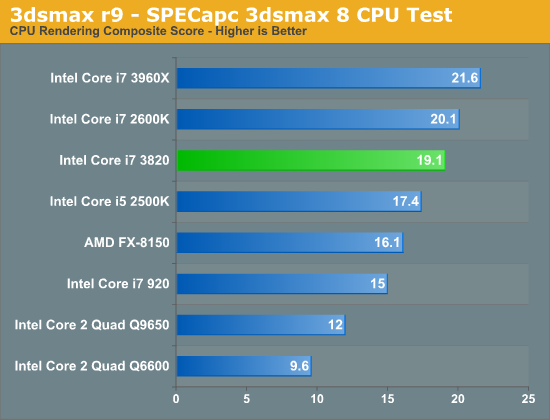
Cinebench 11.5
Created by the Cinema 4D folks we have Cinebench, a popular 3D rendering benchmark that gives us both single and multi-threaded 3D rendering results.
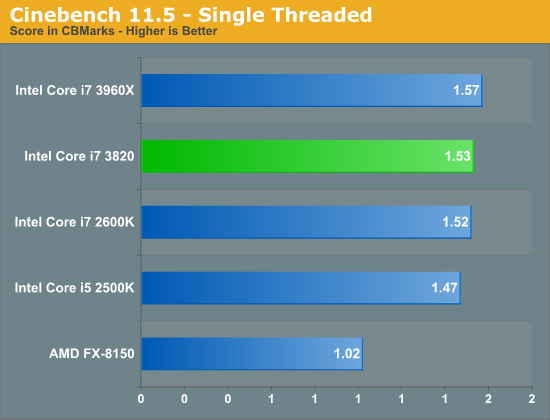
With only a 100MHz clock speed advantage over a 2600K when running in single core turbo mode, the 3820 isn't much faster than the 2600K in our single threaded Cinebench test. The additional L3 cache doesn't have much of an impact here, although I suspect that has more to do with this particular workload rather than a general statement about the 3820. Let's look at multithreaded perf:
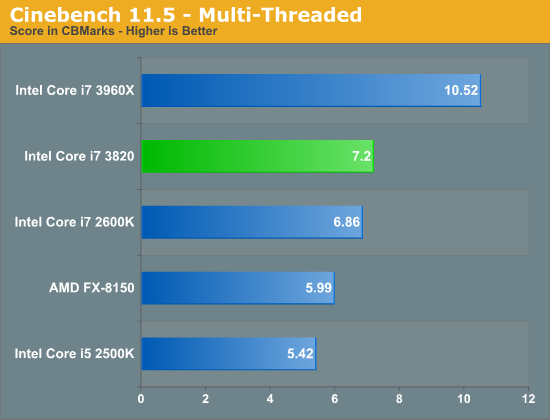
The performance gap increases to 5% once we ramp up thread count. The extra performance is mostly due to clock speed here, although you'll see later on that there are some applications that definitely appreciate the larger L3 cache.
7-Zip Benchmark
While Cinebench shows us multithreaded floating point performance, the 7-zip benchmark gives us an indication of multithreaded integer performance:
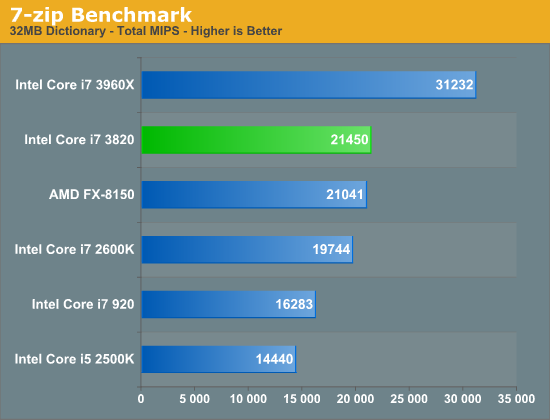
The 7-zip benchmark gives us a good example of what the SNB-E platform can offer given the right workload. Here we see an 8.6% performance advantage, despite a much smaller clock speed advantage. The added L3 cache helps out a bit here, although obviously there's a huge gap between the 3820 and its hexa-core brethren.
PAR2 Benchmark
Par2 is an application used for reconstructing downloaded archives. It can generate parity data from a given archive and later use it to recover the archive
Chuchusoft took the source code of par2cmdline 0.4 and parallelized it using Intel’s Threading Building Blocks 2.1. The result is a version of par2cmdline that can spawn multiple threads to repair par2 archives. For this test we took a 708MB archive, corrupted nearly 60MB of it, and used the multithreaded par2cmdline to recover it. The scores reported are the repair and recover time in seconds.

In tests that have more of an IO influence the difference between the 3820 and the 2600K is negligible, it will take higher clock speeds and more cores to really separate SNB-E from the vanilla SNB systems.
TrueCrypt Benchmark
TrueCrypt is a very popular encryption package that offers full AES-NI support. The application also features a built-in encryption benchmark that we can use to measure CPU performance:
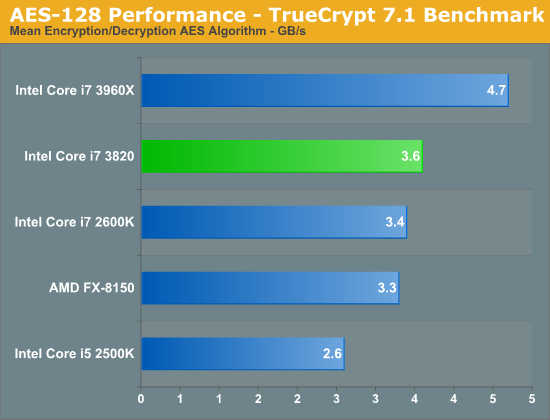
Encryption speed once again scales with core count and clock speeds, the additional L3 cache doesn't do much in this benchmark.
x264 HD 3.03 Benchmark
Graysky's x264 HD test uses x264 to encode a 4Mbps 720p MPEG-2 source. The focus here is on quality rather than speed, thus the benchmark uses a 2-pass encode and reports the average frame rate in each pass.
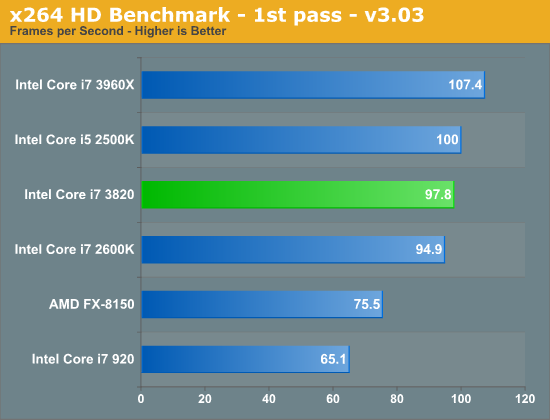
We see a slight advantage over the 2600K in our x264 HD benchmark, however video transcoding doesn't benefit all that much from the small gains the 3820 offers. Most client users would be better off with the Quick Sync enabled 2600K, and the serious video professionals will want to invest in a six-core 3930K at the minimum.
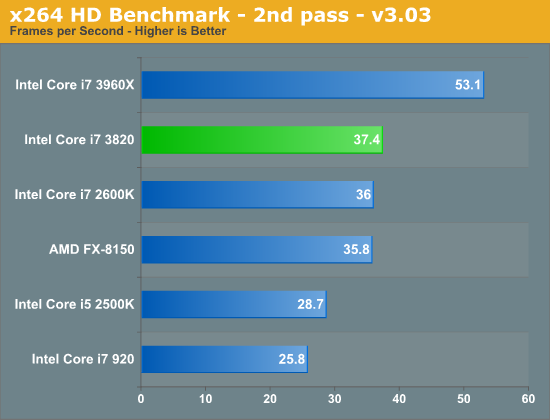
Compile Chromium Test
You guys asked for it and finally I have something I feel is a good software build test. Using Visual Studio 2008 I'm compiling Chromium. It's a pretty huge project that takes over forty minutes to compile from the command line on the Core i3 2100. But the results are repeatable and the compile process will stress all 12 threads at 100% for almost the entire time on a 980X so it works for me.
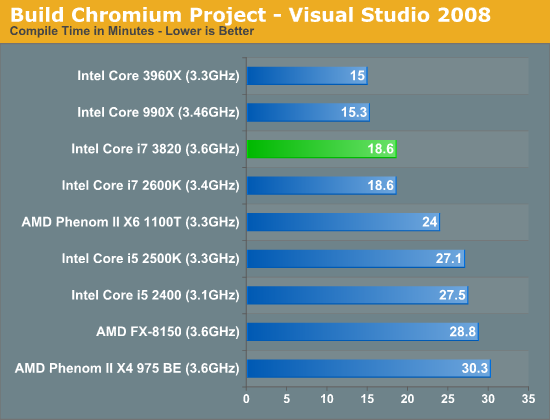
Again we see a step function improvement when moving from four to six cores in our compile test, but no change between the 2600K and 3820. If you're building a dev workstation you're going to either want to save money and grab a 2600K or move to six cores for better performance. It is worth mentioning however that if you need eight DIMM slots the 3820 might be a better option than the 2600K, allowing you to outfit your workstation with insane amounts of memory.
Excel Monte Carlo
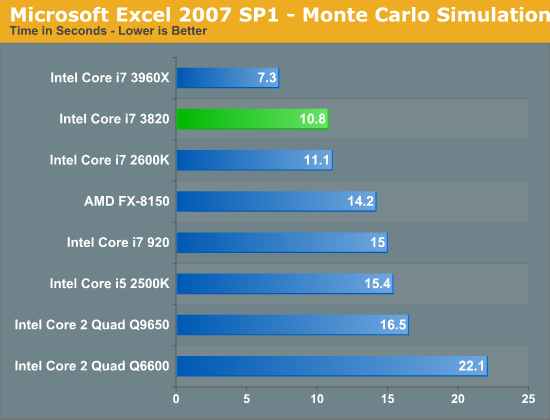
Our Monte Carlo simulation test is CPU bound but the 3820 shows a marginal improvement over the 2600K.
SYSMark 2007 & 2012
Although not the best indication of overall system performance, the SYSMark suites do give us a good idea of lighter workloads than we're used to testing. SYSMark 2007 is a better indication of low thread count performance, although 2012 isn't tremendously better in that regard.
In 2007 we see mild gains over the 2600K, although 2012 shows a much bigger gap between the 3820 and the 2500K due to the former's support for 8 threads vs. 4.
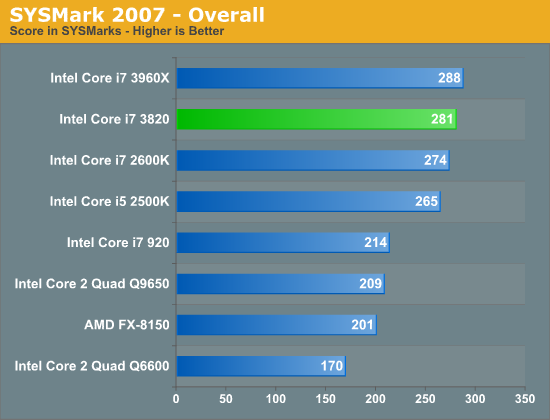
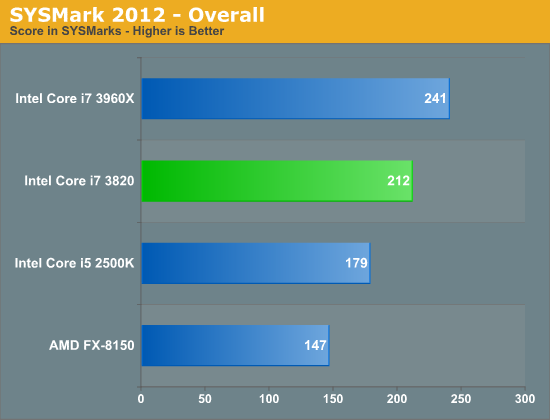










84 Comments
View All Comments
murray13 - Saturday, December 31, 2011 - link
But the rub is, IF your looking at building a system soon, what's the advantage of buying SB over SB-E, other than saving $ on the mb and maybe ram?I've spec'd out systems both ways and they're within 10% of each other (when the 3820's out).
What your saying is that applications won't take advantage of the new hardware even in 3-4 years, they said that 3-4 years ago, too. Today, some are starting to take advantage.
I'm running a 4 year old Intel system that would probably wax the floor with yours and it IS time for me to upgrade...lol.
vol7ron - Sunday, January 1, 2012 - link
this looks interesting but won't ivy bridge be out around the same time?Denithor - Monday, January 2, 2012 - link
The one advantage SB-E offers over IB is more RAM. At max IB will offer 4x8GB or 32GB (and expensive, those 8GB sticks aren't cheap) while SB-E with its 8 slots will hold up to 8x8GB or 64GB.soultraveler - Monday, January 2, 2012 - link
Just wondering if i should just upgrade my 920 cpu and stay on the 1366 platform now seeing as gaming performance hasn't changed much in the past few years. Any thoughts would be much appreciated.DarkStryke - Tuesday, January 3, 2012 - link
Save your money till Ivybridge. SB-E is a waste of money, and a heavily neutered platform chipset currently (x79 was promised with much more then the garbage it ended up being rolled out as).dj christian - Thursday, January 5, 2012 - link
Why isn't this diss board connected to the forums? I can't keep track off my posts or replies.binqq - Friday, January 6, 2012 - link
Our Website: ===== www fashion-long-4biz com ====Our main product list is as follows:
Artifex28 - Monday, January 9, 2012 - link
I am a digital composer and hardcore gamer.My current E6750 @ 3.2GHz has certainly outlived itself and I am looking to upgrade my setup soon.
For gaming purposes, I suppose 3820 would be enough. But I am not sure about the digital composing (DAWs, mixing, sample libraries etc). I am aiming for 24-32GB RAM opposed to the 8 GB I got now. Any thoughts if I should wait for Ivy Bridges or not?
www.soundcloud.com/Artifex28
Denithor - Monday, January 9, 2012 - link
IB probably worth the wait. You will be able to use either 4x8GB (32GB) or 2x8GB + 2x4GB (24GB) with IB. Throw in a nice low power quad and you'll be loving it.SBE would save you like $100-150 because you could go with 8x4GB (32GB). Or you could hit 64GB if you really needed that much RAM.
Artifex28 - Tuesday, January 10, 2012 - link
Thanks Denithor.One more vote for waiting! :)